
Costa Rica
Featured Ports
Puntarenas (Puerto Caldera)
Costa Rica is a small country, about the size of West Virginia, but it's got massive appeal as one of the most ecologically diverse places on earth. Even though Costa Rica covers less than .03 percent of the earth's total surface, you can find nearly five percent of the planet's plant and animal species there. Its location -- between Nicaragua and Panama on the isthmus connecting North and South America, with the Pacific Ocean to the west and the Caribbean Sea to the east -- has enabled flora and fauna from both continents to thrive there.
Cruise passengers visiting Costa Rica's Pacific Coast will come ashore in one of two places -- Puerto Caldera, a commercial port serving the nearby seaside town of Puntarenas, and Puntarenas itself. Puntarenas is a lively town that hosts josefinos (residents of the capital city of San Jose) on holiday, as well as international tourists. The main drag, a wide walkway fronting the beach that's jam-packed with places to shop and eat, is even called Paseo de los Turistas -- loosely, ""stroll of the tourists.""
However, Costa Rica's real draw is its lush, natural beauty and biodiversity -- the ""rich coast"" after which it is named. Most cruise travelers use Puntarenas as a kickoff point for eco-adventures on the ground (horseback riding or hiking in the rainforest), in the water (kayaking, white-water rafting) and even in the air (zip-lining, an activity which originated here and is now popular throughout the Americas and the Caribbean).
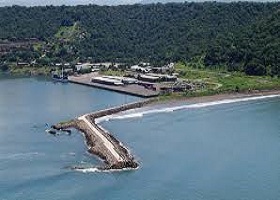
Tortuga Island
This dreamy island paradise fringed with tall swaying coconut palms, sugary white sand beaches and emerald waters invites absolute tranquility and luxury. There are numerous tour operators that will whisk you by boat to Tortuga Island most commonly departing from Jaco or Puntarenas and is about a 90 minute ride with plenty of amazing scenic views.
Once youve arrived spend the glorious day swimming, playing volleyball, hiking the forested hills, or simply sun bathing in the warmth of the sun and beauty of the area. For those seeking adventure take part in the canopy tour and zip line that will fly you through the tree tops giving you a birds eye view of the forest. For some aquatic fun get on a water bike, kayak the coast line or venture out on a glass bottom boat.
A huge attraction to this exotic island is its outstanding scuba diving sites and excellent snorkeling opportunities to view marine life such as sting rays, angel fish, sharks, Spinner dolphins and octopus. Unique and exclusive to the vecinity and all of Central America is the dive site with three sunken boats and diving outfitters that will take you there up close and personal. Its easy to make this destination an unforgettable part of your Costa Rican adventure.
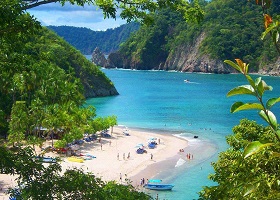
Puerto Quepos
Puerto Quepos drapes itself across a tropical inlet surrounded by primary rainforest. The village center is a delightful six-block square of restaurants, bars, hotels, bakeries, art galleries and gift shops, all fronted by the main beach and sportfishing fleet. Quepos is growing quickly yet maintains many of its sleepy and humble beginnings.
Quepeños are great celebrators of life and seem to make dancing in the streets a local pastime. The high season runs through the drier months of December to April and explodes during the Festival del Mar, a month long party held each February that features concerts, sporting events, parades and a street carnival with dancers from across the country. Quepos fills to the brim with families, surfers, backpackers, ecotourists, blissed-out scientists and gay jet-setters, all as colorful and intriguing as the flora and fauna surrounding the village. The ever-friendly locals take it all in stride, going out of their way to make sure everyone has a good time.
Tourism is now the area's leading employer as Quepos evolves from its banana growing roots into a premier holiday destination. After the demise of the Quepoa Indians in the late 1800's, vast banana plantations were developed throughout the region. Bananas were shipped to world markets across the docks that now service the sportfishing fleet. In the 1980's bananas lost out to heartier African palms and their high quality palm oil. As Quepos diminished in importance as a banana port, it renewed itself as an ecotourism and sportfishing destination. World travelers are discovering the area, with many visitors purchasing homes and returning each year to enjoy the relaxing village lifestyle and natural beauty of nearby Manuel Antonio.
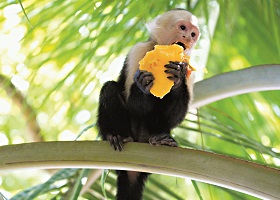
Drake Bay
The quest to get to Drake Bay is an adventure all by itself. From Palmar Norte, head south 9.3 mi (15 km) towards the town of Sierpe. Taxis and buses, which leave multiple times per day, are both convenient methods for making the connection. Once in Sierpe, you can catch a ride down the Sierpe River (Río Sierpe) with a water taxi or a boat. The two hour trip down the river may give the impression of how the area was when Sir Francis Drake himself careened his vessel. Closer to the town of Drake Bay, is a small airport with direct 45 minute flights to and from San José, which leave daily.
Access to the bay is possible with the help of a dirt road during the dry season, however, some of the most memorable and scenic spots can only be reached by boat. Flooding can cause the road leading to Drake to be impossible to pass, so depending on the season, your rental car may not be able to venture past Sierpe. River taxis are the most common form of transportation and give vacationers a lift to the bay for a fairly modest price.
Drake Bay is located 20 mi (32 km) southwest of Palmar. The closest entrance to Corcovado National Park is San Pedrillo, positioned to the south 10 mi (16 km) along the palm lined, shimmering coastline. After paying an entrance fee, hikers can wander in wonder among the various trails that wind throughout the protected park, discovering for themselves why this area, rich in rain forest and wildlife, is so amazing.
Two protected zones abut Corcovado National Park to the southwest of Drake. Protecting an assortment of beach and tropical forest, the 1,235 acre (500 ha) Punta Río Claro National Wildlife Refuge (Refugio Nacional de Vida Silvestre Punta Río Claro) occupies the hills south of the small town of Agujitas. Further south along the coast is the Campanario Biological Reserve (Reserva Biológica Campanario), which offers courses in Neotropical Ecology and very rustic accommodations.
Drake Bay provides a wonderful base to explore the uninhabited Caño Island (Isla del Caño) and the Caño Island Biological Reserve (Reserva Biológica Isla del Caño). One of the most popular and pristine snorkeling locations in the area, the island has remnants from an ancient civilization that carved stone spheres dating back to pre-Columbian eras. The reserve makes up 740 acres (300 ha) of beautiful protected land with trails allowing you to explore this sacred anomaly. Its beaches are frequently visited by olive Ridley sea turtles, who venture ashore to lay their eggs on the sandy beaches. Just offshore, whales and dolphins like to congregate in the temperate waters. Many tours to the island are available from Drake, as the island sits about 10 miles (16 km) offshore.
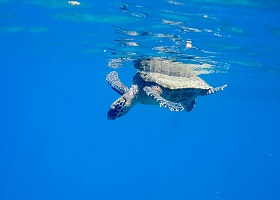
San Juan del Sur
San Juan del Surs small-town lifestyle is centered around the sea. In fact, the majority of San Juans residents make their living from it, fishing or managing dive and snorkel tours in and beyond the picturesque bay. International travelers also find San Juans waters superlative for surfing, fishing, and other water sports, and its neighboring beaches ideal for embracing the Nicaraguan beachfront mantra: Relaxation, with a capital R.
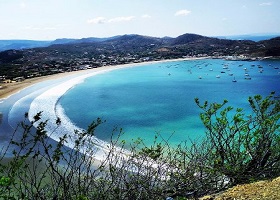
Playa Del Coco
Coco Beach (Playa del Coco) is well known for its popularity with Costa Rica's youth. Seeking fun in the sun, many people pack the beach from end to end on weekends. Although the town is only a small fishing village,
Coco has built great tourism infrastructure, and it is one of the most frequently visited locations in the country. Its white-grey sands sit in a horseshoe-bay and stretch three kilometers to Centinela Point
Unlike most Beaches in the Papagayo region of Guanacaste, Coco's water composition maintains a unique blue-gray tint, instead of the area's usual blue-green. The laidback beach is a favorite for both foreigners and Ticos who frequently take part in the town's ongoing fiesta. Coco's party grows in size and intensity after the end of rainy season, and at times, the beach can feel overrun with visitors. It is busiest during late November and December when most Ticos take their main holiday. Travelers seeking a laidback environment, free of noise, should probably steer clear of Coco Beach. However, those visitors in search of a party should look no further.
Nightlife can be found in the bars with close proximity to the town's central plaza. Other entertainment venues include casinos and discos. Restaurants are widespread, and many restaurants may double as bars after nightfall. In addition to these nightlife activities, Playa del Coco offers a wide range of ocean activities, whether it is world-class sport fishing, snorkeling, Scuba Diving, or relaxing on a boat and on the beach.
Coco is the largest of the Papagayo villages, and services are abundant. Facilities such as shops and supermarkets are available throughout town. The village center looks rundown compared to the usual opulence found along Guanacaste's northern coast. However, the Coco area does offer its share of luxury resorts. Affordable accommodations are also plentiful, attracting a number of locals and budget travelers throughout the year.
As for arriving at Coco from abroad, the Daniel Oduber Quiros International Airport in Liberia facilitates seamless travel to the region. Otherwise, driving from San Jose takes about five hours by car. Buses from either Liberia or San Jose run daily.
Not far from Coco Beach is Marino Las Baulas National Park (Parque Nacional Marino las Baulas). At Marino Las Baulas, visitors may be fortunate enough to experience the once in a lifetime opportunity of seeing mass turtle nesting behavior (arribadas). The Leatherback, Pacific Green, and Hawksbill turtles all make their nests in this area. During an arribada, a large mass of turtles-sometimes thousands-storm the beach to lay eggs. By laying their eggs simultaneously, individual turtles increase the likelihood their nest will survive predation.
Curu National Wildlife Refuge Nicoya Peninsula Region of Costa Rica
Westbound on the road from Paquera is this small, yet biologically rich coastal refuge near the town of Curu. Before being purchased from the Pacific Lumber Company in the 1930's, the land that now makes up the Curu National Wildlife Refuge was used for small-scale cattle grazing and a sustainable development project consisting of agricultural production and selective logging endeavors.
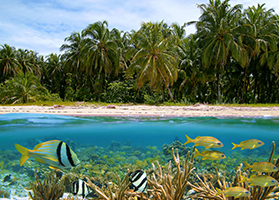
Curu National Wildlife Refuge
By 1981 the area's dry and wet tropical forests received protective status which opened the door for the foundation of the national park, established only two years later.
This 208 acre (84 ha) refuge forms the heart of the larger 3,696 acre (1,496 ha) private cattle ranch that originally encompassed the entire area in the 1930's. The area is home to 232 different bird species as well as a multitude of plant and animal life common to the region. The Curu River winds its way through the park, fueling the complex mangrove ecosystem that borders its murky waters. The swampy river bank transitions into a combination of wet and dry tropical forest which is common in Nicoya's south, further inland.
Leatherback and Olive Ridley turtles use the park's white-sand beach to lay eggs during nesting season. The beach also offers rudimentary cabin accommodations at $6 a bed, per night-a great option for visitors seeking ample time in the park to explore its many wonders. Here, food and horse rentals are available at a modest price.
Accommodations can be made at any of the surrounding tourist towns, as well as guided tours through the park. Because Curu is privately owned, there are also some rustic lodges onsite that can be rented.
The road to Curu is unpaved, thus a four-wheel drive vehicle is necessary to navigate the area.
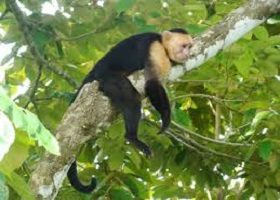
Best time to Visit
Nov to Apr


